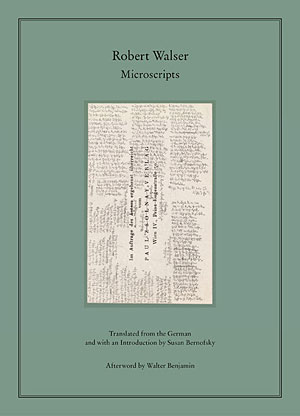
by by Margaret Kolb

Published by New Directions, 2010 | 160 pages
Walter Benjamin called Robert Walser an “extraordinar[il]y” style-less writer. By this he did not mean that Walser’s language is inept, but that it is reticent; that its invigorating force comes from the obstinacy with which it avoids a grand literary style, from the sincerity with which it yields to a fragile, whimsical nervousness. The aim of Microscripts, a recent translation of selected of Walser’s minor writings, is to bring out the material aspects of this nervousness, in texts where it takes what might be its most extreme form. The volume collects twenty-five short sketches Walser penciled in microscopic script on loose strips of paper: business cards, envelopes, duodecimo pulp fiction covers. Carefully chosen and lovingly presented, Microscripts is a moving introduction to Walser’s work at its most miniature, and most beautiful.
From the first, Walser’s writing tended towards a small, idiosyncratic form. Born in Switzerland around the turn of the century, Robert Walser worked odd jobs—among others, as a servant and an inventor’s assistant—while pursuing an increasingly successful writer’s career. He published some poems and novels; the main bulk of his writing, however, consisted of short stories and sketches. It is for these stories and sketches that he became most widely recognized. His writing achieved its first peak of popularity in the 1920s, influencing writers such as Herman Hesse and Franz Kafka. Controversially diagnosed with schizophrenia thirteen years later, he spent the rest of his life at a mental institution and was virtually forgotten for fifty years.
In the 1970s, when Walser’s star again began to rise, an overlooked portion of his manuscripts began to attract attention. In addition to the final drafts he had sent to his publishers over the years, Walser had preserved 526 diminutive pages of paper covered with tiny, seemingly incoherent markings. Earlier scholars had discarded them as a madman’s scribbles. Coming back to his work half a century later, the next generation of researchers discovered them to be first versions of Walser’s short sketches written in a miniscule version of Kurrent a medieval German script. Many of these drafts had been published with virtually no corrections; others, especially later ones, had never before appeared in print.
The aim of Microscripts is to return to these first drafts as both products of Walser’s writing and sites at which this writing took place. The volume sets German transcripts of these drafts, and their English translations, against facsimile images that present these texts to us in their original size and shape. Illegible without a magnifying glass, these facsimiles offer a touching bird’s eye view of the multiple directions Walser’s mind seems to veer in.
To read Microscripts is, first, to experience the physical fragility and whimsicality of Walser’s writing. He pencils rather than pens his pieces. This is to help them remain sketches, to reassure him they need be nothing else. Each draft is a small visual poem. The qualities of his medium, a quotidian printed page, inspire the rhythm and shape of the story with which it is soon densely, obsessively filled. Walser obviously delights in juxtaposing his tiny, sticklike script against the sturdier, inked font of a letterhead or a book title; in mingling vertical and horizontal lines, solid blocks of text and loose words or phrases. Some drafts come together, sentence by sentence, out of small archipelagoes of writing; others are framed and illuminated into mock-medieval manuscripts.
In their outward appearance, the microscripts give an impression of simultaneous whimsicality and intense concentration; of, at once, a precariously intense focus and a wandering imagination that constantly reinvents its bounds. This impression is echoed, and heightened, in the content of Walser’s writing. The aim of each phrase Walser pencils is not to twine but to fray its precedent. His is a mind impatient with itself, always jumping to qualify or diffuse its prior observations:
All those present-day kisses failed to possess in sufficient measure the instantaneous smoldering inflammation and flaming incandescence she longed for….
She appeared capable of loving neither anything other than herself nor exclusively her own person, and the snakes of that Cleopatra who’d come before never slithered into the vicinity of her successor.
What use is it to take as one’s example a paragon beyond one’s reach?
In their content, most of the microscripts gathered in the volume, like the above quote, are ambiguous, simultaneously comic and troubling portraits of Walser’s contemporaries. Paradoxically, rather than work to the fragments’ detriment, this nervous, self-conscious fragmentation might be the sketches’ greatest strength. It makes Walser’s characters seem at once vulnerable and hauntingly elusive; prone to disfigurement by each new phrase imposed upon them, but also never fully reachable, never adequately summarizable, through any single image or phrase. These qualities let each sketch be both a brilliant ironic dissection of social typologies and a celebration of the individual’s hidden, inexpressible complexity. In this unassuming but poignant fashion, Walser’s pieces expose and engage with some of the towering issues of modernist society: the crisis of social tradition; the new power, and new fragility, of the individual no longer stably held within tradition’s grids; the self-consciously ephemeral quality art needs to adopt to respond to these changes.Much more could be said about Robert Walser’s Microscripts: about their theories of love and beauty, their oscillation between the parable and the realist story, their simultaneous tenderness for and fear of human selfishness. The introduction by Susan Bernofsky and afterword by Walter Benjamin included in the volume both offer points of entry into such a more sustained study of the volume. What is undoubted, even at a first read, is that the book deserves such more sustained attention: both as a new point of entry into Walser’s writing, and as a new lens onto modernism as such.
Marta Figlerowicz is a graduate student in English at the University of California, Berkeley. Her criticism and creative writing have appeared in, among others, New Literary History, Dix-huitieme siecle, Prooftexts, The Harvard Advocate, and The Harvard Book Review.















click to see who
MAKE Magazine Publisher MAKE Literary Productions Managing Editor Chamandeep Bains Assistant Managing Editor and Web Editor Kenneth Guay Fiction Editor Kamilah Foreman Nonfiction Editor Jessica Anne Poetry Editor Joel Craig Intercambio Poetry Editor Daniel Borzutzky Intercambio Prose Editor Brenda Lozano Latin American Art Portfolio Editor Alejandro Almanza Pereda Reviews Editor Mark Molloy Portfolio Art Editor Sarah Kramer Creative Director Joshua Hauth, Hauthwares Webmaster Johnathan Crawford Proofreader/Copy Editor Sarah Kramer Associate Fiction Editors LC Fiore, Jim Kourlas, Kerstin Schaars Contributing Editors Kyle Beachy, Steffi Drewes, Katie Geha, Kathleen Rooney Social Media Coordinator Jennifer De Poorter
MAKE Literary Productions, NFP Co-directors, Sarah Dodson and Joel Craig